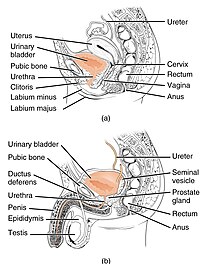
Photo from wikipedia
OBJECTIVES Our primary aim was to determine bowel and bladder function in children aged one month to seven years in the general Dutch population. Second, we aimed to identify demographic… Click to show full abstract
OBJECTIVES Our primary aim was to determine bowel and bladder function in children aged one month to seven years in the general Dutch population. Second, we aimed to identify demographic factors associated with the presence of bowel and bladder dysfunction, and their coexistence. METHODS For this cross-sectional, population-based study, parents/caregivers of children aged from one month to seven years were asked to complete the Early Pediatric Groningen Defecation and Fecal Continence questionnaire. Different parameters of bowel and bladder function were assessed using validated scoring systems such as the Rome IV criteria. RESULTS The mean age of the study population (N = 791) was 3.9 ± 2.2 years. The mean age at which parents/caregivers considered their child fully toilet-trained was 5.1 ± 1.5 years. Prevalence of fecal incontinence among toilet-trained children was 12%. Overall prevalence of constipation was 14%, with a constant probability and severity at all ages. We found significant associations between fecal incontinence and constipation (OR = 3.88, 95% CI, 2.06-7.30), fecal incontinence and urinary incontinence (OR = 5.26, 95% CI, 2.78-9.98), and constipation and urinary incontinence (OR = 2.06, 95% CI, 1.24-3.42). CONCLUSIONS Even though most children are fully toilet-trained at five years, fecal incontinence is common. Constipation appears to be common in infants, toddlers, and older children. Fecal incontinence and constipation frequently coexist and are often accompanied by urinary incontinence. Increased awareness of bowel and bladder dysfunction in infants, toddlers, and young children is required to prevent these problems from continuing at older ages.
Journal Title: Journal of pediatric gastroenterology and nutrition
Year Published: 2023
Link to full text (if available)
Share on Social Media: Sign Up to like & get
recommendations!